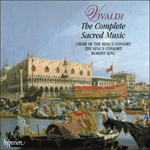This is one of three surviving solo motets that we know (from the evidence of the paper on which the manuscript was written) to have been composed during Vivaldi’s sojourns in Rome during the carnival seasons of 1723 and 1724. These works were most likely written for some of the singers who performed in his three operas written for the Capranica theatre in Rome: Ercole su’l Termodonte, Il Tigrane and Giustino. RV631 is a motet per ogni tempo—‘for all seasons’. Its Latin text, contaminated as always by Arcadian language borrowed from the secular sphere, is a prayer for the deliverance of the believer from earthly delights and for his espousal of heavenly ones. Vivaldi chooses the gentle E flat major as his central key, and the abundant ‘sighing’ appoggiaturas in the first aria conjure up very well the ever-present blandishments of the world. The second aria, in C minor, uses the traditional lamento bass (a descent by chromatic steps from tonic to dominant), perhaps a little ironically, to convey the wilting of a rose. In a final ‘Alleluia’ the soprano dissolves all the argument in an exultant display of virtuosity.
from notes by Michael Talbot © 1999
Cette pièce est l’un des trois motets solistes connus; le papier du manuscrit nous apprend que ces motets—très probablement destinés à certains des interprètes des trois opéras vivaldiens composés pour le théâtre Capranica de Rome: Ercole su’l Termodonte, Il Tigrane et Giustino—furent écrits lors des séjours romains de Vivaldi, durant les saisons carnavalesques de 1723 et 1724. RV631 est un motet per ogni tempo, «pour toutes les saisons». Son texte latin, contaminé, comme toujours, par le langage arcadien emprunté au domaine profane, est une prière pour que le croyant soit délivré des charmes terrestres et épouse les délices célestes. Vivaldi choisit pour tonalité centrale le doux mi bémol majeur, et les abondantes appoggiatures «soupirantes» de la première aria symbolisent très bien les blandices perpétuelles du monde. La seconde aria, en ut mineur, recourt à la traditionnelle basse de lamento (une descente, par degrés chromatiques, de la tonique à la dominante), peut-être un peu ironiquement, pour traduire la flétrissure d’une rose. Dans un ultime «Alléluia», la soprano dissout tout l’argument en une exultante démonstration de virtuosité.
extrait des notes rédigées par Michael Talbot © 1999
Français: Hyperion Records Ltd
Dies ist eine von drei erhaltenen Solomotetten, von denen wir (auf Grund von Untersuchungen des Manuskriptpapiers) wissen, daß sie während Vivaldis Aufenthalten in Rom 1723 und 1724 jeweils zur Karnevalzeit entstanden sind. Höchstwahrscheinlich wurden sie für einige der Sänger geschrieben, die in seinen drei für das Capranica-Theater in Rom verfassten Opern auftraten: in Ercole su’l Termodonte, Il Tigrane und Giustino. RV631 ist eine Motette per ogni tempo—„für jede Witterung“. Ihr lateinischer Text, in den sich wie immer aus der säkularen Sphäre entlehnte arkadische Elemente einschleichen, ist ein Gebet darum, daß sich der Gläubige von irdischen Genüssen lösen und denen des Himmels hingeben möge. Vivaldi wählt das sanfte Es-Dur als Grundtonart, und die zahllosen „seufzenden“ Appoggiaturen der ersten Arie beschwören höchst gekonnt die allgegenwärtigen Verlockungen der Welt herauf. Die zweite Arie in c-Moll verwendet, möglicherweise ein wenig ironisch, den traditionellen Lamento-Baß (einen chromatischen Abstieg von der Tonika zur Dominanten), um das Welken einer Rose darzustellen. Im abschließenden „Alleluja“ löst der Sopran die ganze Auseinandersetzung in einer frohlockend virtuosen Darbietung auf.
aus dem Begleittext von Michael Talbot © 1999
Deutsch: Anne Steeb/Bernd Müller


 Vivaldi: The Complete Sacred Music
Vivaldi: The Complete Sacred Music
